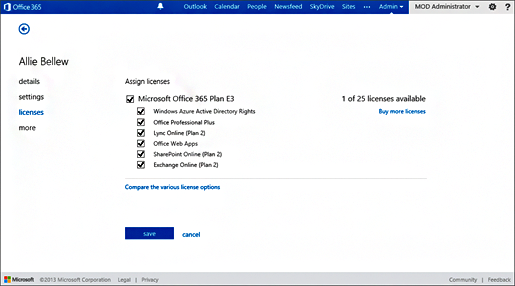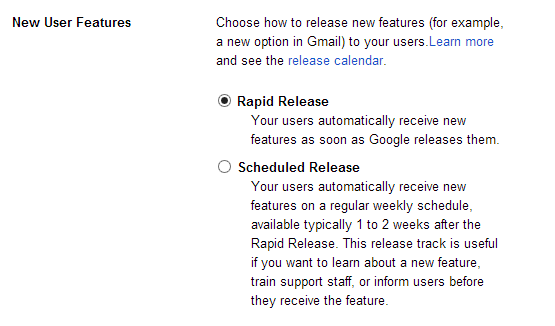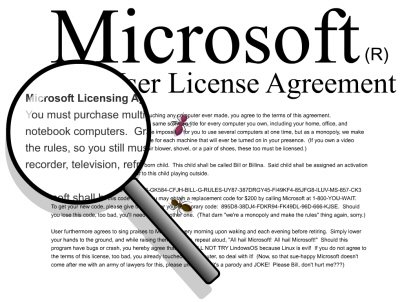4 big reasons why renting software as a subscription makes sense
 It's a fairly typical situation these days: a small business approaches me with a need to replace an aging Exchange 2003 server and Office 2003 for 14 users. They want to compare purchasing their upgrades outright vs just renting them from Microsoft. The in-house server approach for email and Office software will run them roughly $10K USD before any consulting labor -- or they could opt to have us move them into Office 365 E3 for $280/month.
It's a fairly typical situation these days: a small business approaches me with a need to replace an aging Exchange 2003 server and Office 2003 for 14 users. They want to compare purchasing their upgrades outright vs just renting them from Microsoft. The in-house server approach for email and Office software will run them roughly $10K USD before any consulting labor -- or they could opt to have us move them into Office 365 E3 for $280/month.
At face value, sure, you could say that the in-house approach pays for itself in just about 3 years compared to paying for Office 365 E3 over that period of time. But you're squarely forgetting about all the hidden nasties which I brought into full light in a previous article on the TCO of cloud vs on-premise technology.
That in-house server will suck down gobs of electricity every month. You'll still need to pay companies like mine to support and manage that server each month. And the "5 year rule" will have you back at the drawing board, pricing out a new server, licensing, and consulting costs once over in due time.
On the other hand, going the Office 365 E3 route affords you access to the latest Office edition (in Mac and Windows flavors) on up to 5 machines for each worker, plus access to Lync, SharePoint, 50GB email inboxes, as well as industry leading security compliance and 24/7 uptime guarantees. I'm not trying to sound like a Microsoft salesperson, but for all intents and purposes, the modern rented alternative sells itself.
I'm not preaching an unwelcome message here. A clear majority of our customers are finding the cloud route, or SaaS (software as a subscription) to make financial and technical sense for their organizations. In an age where Microsoft software release cycles have been cut in more than half, and the incentives on renting vs buying are becoming hard to ignore, rarely does it make sense to view technology purchasing in the eyes of a CAPEX perspective.
Treating our modern software needs as an OPEX cost aligns business financials with a direct need to convert 6-8 year plans into 24-36 month modernization cycles.
The Case for OPEX Over CAPEX Is Hard to Ignore
Ever since we started offering Google Apps to customers back in early 2011, we've been trying to make the case for why turning software purchasing theory on its head is the future. For a while it used to be a tough sell. Many considered it heresy not to have full ownership over the licenses and hardware used to conduct your business.
A recent op/ed by Don Jones from Redmond Magazine put this discussion back into full focus. He was spot-on in wading past the usual marketing bliss offered by cloud vendors and putting a concrete dollars and sense position back into the argument.
"Many IT decision makers are pushing back. Some are doing so for valid reasons and some not so much," Don wrote in his piece. "You know who's almost never pushing back, though? The CFO. That's because the CFO has a special tool IT decision makers often lack -- a calculator."
His op/ed touched on numerous aspects which I fully agree with, but the one which business owners will care a lot about -- namely the CAPEX vs OPEX debate -- reared its head in a logical way. Don correctly asserted, "Buy a piece of software and in most cases you can't write off the expense as a capital investment right away. You have to depreciate it over five years." With Microsoft churning out a release cadence of 2-3 years on average now for Windows and Office editions, does the status quo make sense anymore?
"With rentals, you write off the entire amount in the same year you make the payment. Your bookkeeping becomes slightly easier. You're no longer sitting on capital investments that have yet to be depreciated," Don continued. And he's exactly right: are you truly benefiting from a five year depreciation schedule? And how many businesses truly take advantage of converting any leftover value on their older software by putting it on the auction block? I haven't worked with any.
Purchased software turns out to be worse than a new car. Activate that license serial code, and you know for a fact you're getting nothing in return on the backend. A pretty lousy deal these days, if you ask me.
Scale Up, Scale Down On a Whim
Don briefly touched on this same aspect in his op/ed I mentioned above. A lot of companies that we work with use outside contractors that are provided internal email accounts for image consistency. If your company had a project that was bringing 25 new contractors in the loop, the old way of doing business meant you purchased extra sets of Exchange licenses for them in bulk. One year later, when the project was over, you ate that sunk cost hard, especially if you were experiencing downturns in the number of contractors being brought on -- meaning many licenses sat idle and went unused (perhaps indefinitely).

Traditional licensing is a nasty affair in forecasting, budgeting, and tracking usage counts. The cloud rental approach flips this mess on its head. Office 365 licenses (above), for example, can be added in a matter of clicks, and Microsoft allows for you to scale up in hundreds or thousands of licenses in a single purchase. Trimming your needs is just as easy. Licensing is no longer a CAPEX sunk cost. (Image Source: Microsoft TechNet)
The 2013 way of handling this in a platform like Office 365 entails purchasing a subscription for these 25 contractors, and dumping the licenses when the project is over. No sunk CAPEX costs to worry about, no depreciation to tangle with. It's done and over, and these users can be turned on and off with an hour of work on a web-based administration console. Sure beats the drawn out process of getting approval on a license pack purchase, waiting for its delivery, and asking your IT support team to install and configure the licensing along with new accounts on your own server.
This same methodology is great for businesses that deal with seasonal workers, like landscapers and general contractors and retail businesses. The old way of handling licensing meant they had to bulk up their licensing portfolios just for the times when they were super busy with large staff counts for a few months out of the year. Now, with software rentals, scaling up and down doesn't have to be a regretful experience. It happens just because it has to.
Rapid Release Is The New Status Quo
Microsoft delivered the sizable Office 2003 suite in the year that it's titled after. Four years later, Office 2007 hit the scene. Just three years after that we had Office 2010, and a mere two years later Office 2013 came upon us. Catch the pattern? Microsoft's release schedules are looking eerily similar to that of Google's, which doesn't even place versions on Google Apps. New features are being streamed into the Apps platform at a rate of 2-3 per month now, sometimes more.
It's no secret that Microsoft keeping its product line on the bleeding edge of freshness is a market necessity these days, especially up against Google's business email suite. Tony Redmond from Windows IT Pro just a few days ago penned about how Microsoft views Office 365 for Business as the ultimate "dogfood" environment for what its on-premise editions of Exchange Server will be getting upon release.
Tony explained in detail how "Office 365 runs code for weeks or months before the code is packaged and provided to on-premises customers... I see lots of goodness here because a solid shake-down by running code used by millions of cloud mailboxes seems like an excellent way to find bugs." I fully agree.
Microsoft and Google aren't alone in their shift to subscription based software models. Adobe destroyed any hope that boxed editions of Creative Suite would continue hitting shelves, as Creative Cloud was launched as the new norm for all things Adobe. David Pogue of the New York Times weighed in on the dizzying array of pricing and feature levels that CC offers. For some users, it's a much cheaper way to use Adobe product. For some, slightly more expensive. But one thing holds true across the board: if you're on Creative Cloud, you're never out of date.
Not only does the Office 365 and Google Apps approach to software bring new features to users at a much faster rate, but they also solve this oft-forgotten IT black hole: many on-premise servers remain unpatched for months, if not years, over the course of their lifespan.
Even larger organizations with dedicated IT staffs aren't always shining stars as you may suspect. You don't want to know how many times I've been met with blank stares by IT staff when I was brought in for consulting projects and the question of "what kind of patching routine do you have?" is asked. Shocking, but not surprising, knowing how many IT pros prefer a path of least resistance in keeping systems up and running.
Swinging back around to an earlier point, I wonder how much tougher it is to justify the expenditure of new software suites like Office 2013 when you know for a fact that Microsoft will have a new release available in just 12-24 months time? Sure, you could opt to skip releases like many organizations regularly choose to do, but at what point will falling further behind become a business need that has to be addressed?

Google Apps has perhaps one of the fastest agile development schedules in the cloud email industry. The above screenshot from my company's Google Apps domain (above) shows the existence of an option Google offers just so companies can slow down the pace at which new features are introduced to their internal users. Microsoft is moving Office 365 to a similar release schedule with each passing month. But I don't see this as necessarily a bad thing.
The margins of competitive edge are being driven closer and closer together. Having those extra few features that save you just a little more time and allow for an extra couple dozen of sales will increasingly mean the difference between leading your industry and being left in the dust. I may be ahead of the curve with this assertion, but give the business world 5-10 years. Being 2-3 editions out of date will be the death of many if software development cadence keeps moving in the direction it's already headed.
We started the software space race in the realm of the cloud; slowly shifted over to virtualization; now the next big battlefields are already shaping up in unified communications (UC) and Desktop as a Service (DaaS). Renting software is becoming increasingly key to maintaining competitive advantage by avoiding software stagnation.
Who's Policing Your Internal Licensing?
Organizations such as the Business Software Alliance (BSA) work on behalf of software big shots like Microsoft, Adobe, and Apple to name a few, in cracking down on all things related to illegal licensing practices. Piracy among large organizations is still a big issue for the industry, no doubt, but a lot of the unsung victims of software licensing messes are far from determined white collar criminals.
They're business owners like the ones I consult with regularly who merely don't have licensing experts on staff that have a degree in the byzantine rules set forth by the likes of Adobe or Microsoft. They get entangled in honest mistakes of over-installing copies of Office or Creative Suite on their machines, and get penalized in the form of audits by the software makers.
I feel sorry for those who get dogged in penalties but never meant to do any harm; those who actually really tried to keep in line with proper licensing. Even simple calls to my rep at CDW about licensing for things like SPLA from Microsoft leads to days of delay and numerous rounds of emails between "licensing experts" at the distributor's offices. I guess I'm not the only business owner who can't wade through the volumes of licensing SKUs and subtext without coming out more confused afterwards than when I started.
And if you think having a coveted "Enterprise Agreement" with Microsoft is some sort of panacea, guess again. I spoke candidly with an industry colleague who works for a to-be-unnamed cloud tax software company in northern Illinois (USA), that happens to have an EA with Microsoft, and she was brutally honest about what getting and keeping such licensing status entails. Hours upon hours wasted in preparing usage counts in huge spreadsheets, determining shortcomings or over-allotments of given licenses, and then re-negotiating pricing with a Microsoft representative. This is a yearly or bi-yearly affair, mind you.

Microsoft touts its Enterprise Agreements as a way to "streamline" licensing for organizations, but anyone with insider knowledge knows this is anything but the case. Rented license platforms like Office 365 put the ball squarely in Microsoft's court for keeping accurate license counts, and prevents companies from overpaying on unused licenses. It forces an honest hand from each side of the table, and eliminates the dizzying self-policing organizations under EAs with Microsoft had to endure. (Image Source: MaximumPC)
Whatever savings may be gained on a per-unit basis from pricey SKUs like SQL Server or Lync Server get slowly washed away in the reality that companies are likely over-committing themselves to higher license levels just to stay on the legal side of licensing themselves, in case Microsoft asks to do a complete audit of their license usage counts. Each infraction brings a penalty, further dwindling any semblance of savings away.
Microsoft isn't the only software giant guilty of making licensing a living hell for IT professionals. Adobe, Oracle, Apple and all the rest have similar structures and policies in place to complicate licensing past the point of knowledge by the average person. Some licensing apologists make the claim that this is a necessary evil due to the amount of piracy out in the world today, but I opt to believe that there has to be a better way to treat customers.
Welcome Software as a Subscription (SaaS). It solves nearly all of these ills in one swoop. Since companies like Microsoft and Adobe are charging you by the month for their software, the onus to be fair on license counts is a two way street. A company won't pay any more than what it needs to license on a rental basis, and likewise, the vendor ensures that it is receiving honest compensation for what is being rented out.
Teleworkers or contractors that need access to short term licenses can also be easily accounted for down to a T. For example, Microsoft gives away 5 copies of Office for each Office 365 E3 user you license. As soon as that account is disabled by an organization, all instances of Office tied to that former user get disabled -- as should be the case in an ideal world. You're not hounding former staff to play honestly by ridding their machines of Office licenses, and Microsoft isn't breathing down your back in licensing audits anymore. The technology polices itself, turning software licensing from a hated necessity to a mere fact of business life.
You end your lease on a car from the dealer, and you have no choice but to hand back the set of keys. Software is finally shifting to work in this same manner when it comes to Office 365, Creative Cloud, Google Apps -- name your pick. Is this really such a bad thing? Unless you made a living as a software licensing specialist or consultant, in which case, I feel sorry for you doubly.
Purchasing Software Will Soon Become Passé
The modern business world is moving too fast to be kept back by five year release schedules and purchasing/implementation cycles that take just as long. While the small and midsize business sectors are taking up the notion of rented software at a faster pace than big business, it's only a matter of time until it makes sense for organizations of all sizes.
Purchased software licensing carries a lot of negative baggage. From unfriendly five year depreciation schedules, to licensing-tracking nightmares, down to apathetic approaches to internal patching routines fostering insecure computing environments. I won't trust big software companies with everything they do, but when it comes to rented licensing like Office 365 and Creative Cloud, I genuinely believe they're onto something genius here.
My own company FireLogic rents (almost) every software license we need today. Our email runs exclusively on rented Office 365 inboxes. A rented QuickBooks Online subscription is how we keep our books. Our "file server" is now in essence a team site in the rented SharePoint Online ecosystem, which is part of Office 365. And we handle all inter-staff IM along with web conferencing over Lync Online -- once again, a rented piece in Office 365 land.
I know very well that there are still situations, however, that benefit from outright purchasing. But I'm personally seeing these as far and few in-between as time goes on. Maybe we can tear down the Berlin Wall that is traditional software licensing once and for all by the end of the decade. That would be a tyranny few would miss.
Photo Credit: alexmillos/Shutterstock
 Derrick Wlodarz is an IT Specialist who owns Park Ridge, IL (USA) based technology consulting & service company FireLogic, with over eight+ years of IT experience in the private and public sectors. He holds numerous technical credentials from Microsoft, Google, and CompTIA and specializes in consulting customers on growing hot technologies such as Office 365, Google Apps, cloud-hosted VoIP, among others. Derrick is an active member of CompTIA's Subject Matter Expert Technical Advisory Council that shapes the future of CompTIA exams across the world. You can reach him at derrick at wlodarz dot net.
Derrick Wlodarz is an IT Specialist who owns Park Ridge, IL (USA) based technology consulting & service company FireLogic, with over eight+ years of IT experience in the private and public sectors. He holds numerous technical credentials from Microsoft, Google, and CompTIA and specializes in consulting customers on growing hot technologies such as Office 365, Google Apps, cloud-hosted VoIP, among others. Derrick is an active member of CompTIA's Subject Matter Expert Technical Advisory Council that shapes the future of CompTIA exams across the world. You can reach him at derrick at wlodarz dot net.
